Salmon Onigiri
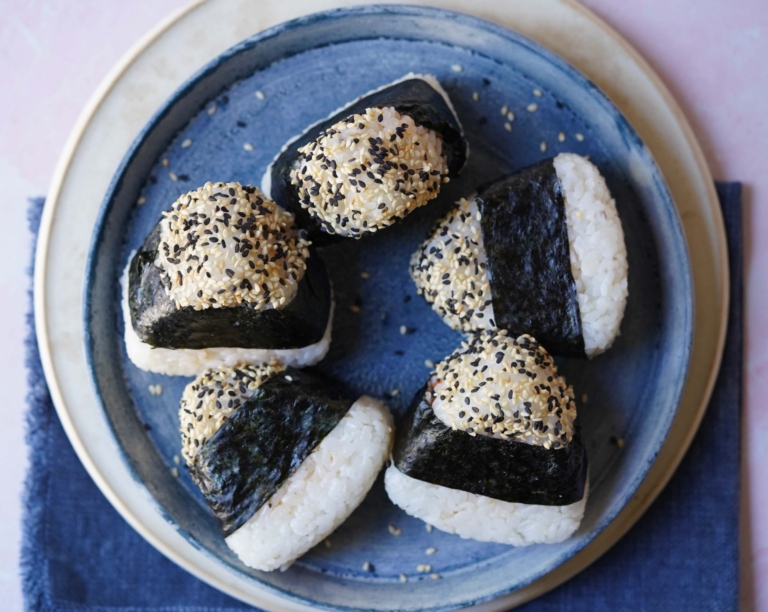
Onigiri, also known as “omusubi” or “nigirimeshi“, is a quintessential Japanese snack, that merges tradition with innovation in a delectable rice ball. Onigiri, or rice balls, date back to the Heian period (794-1185), cherished for their convenience and versatility. Typically filled with savory ingredients and wrapped in nori (seaweed), onigiri has been a staple of Japanese cuisine for centuries, enjoyed during lunch, picnics, or as a quick snack. Onigiri is deeply rooted in Japanese culture, it’s a comfort food for many, evoking a sense of nostalgia and homeliness.
My favorite kind of onigiri is a version of spicy salmon onigiri which in my recipe uses fresh sashimi-grade salmon, tossed with a simple mixture of ponzu sauce, sesame oil, and chili garlic sauce. The result is a flavorful filling that infuses the onigiri with a burst of heat and ocean freshness.
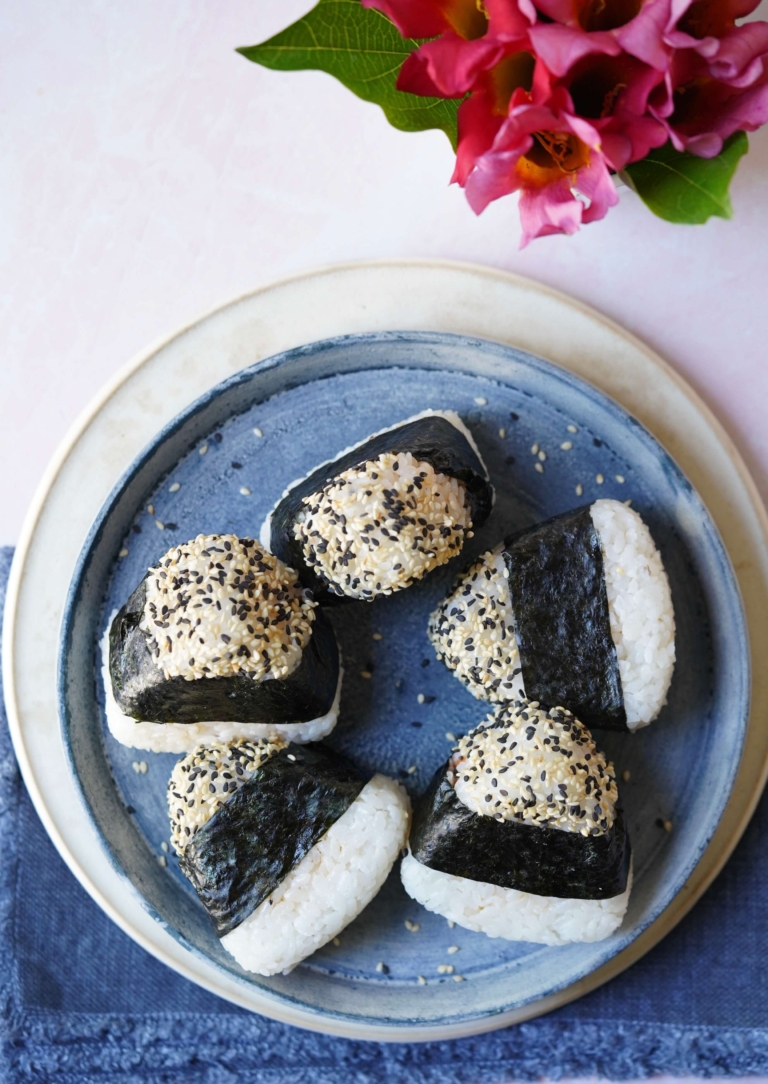
To craft this traditional Japanese snack food, a small mold is advised. One can make them without the mold, but it’s a bit more involved. The hand-held triangular mold shapes the rice into perfect triangular forms, ensuring consistency and ease. But despite my recommendation for using a press, the process of making onigiri is uncomplicated and quick. Begin by pressing a layer of warm sushi rice into the mold, create a small indentation, and add a generous spoonful of the spicy salmon mixture. Top with another layer of rice and press firmly. Once shaped, the Onigiri is wrapped in a strip of nori for added flavor and texture. Sesame seeds on the outside are optional, but I love to include them for texture.
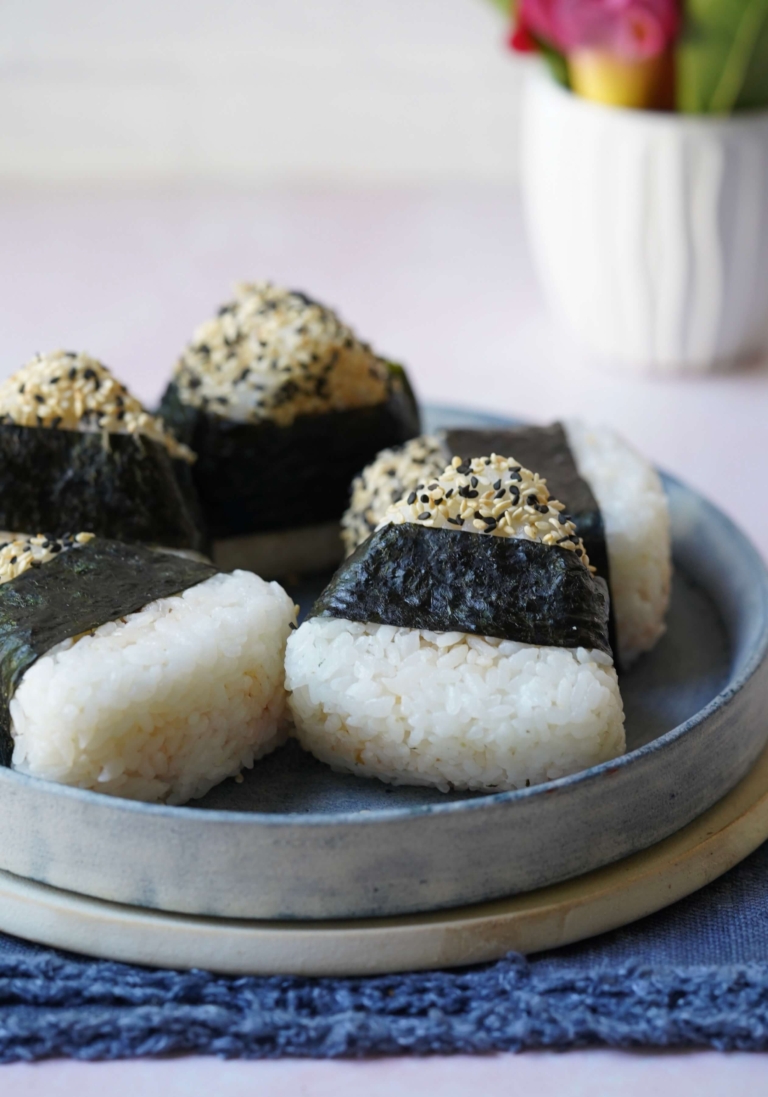
Onigiri, which is perfect as a portable snack or a light meal, became popular in Japanese convenience stores (Konbini) such as Seven-Eleven in the late 1970s and early 1980s. As Japan’s economy grew and lifestyles became busier, there was an increasing demand for quick, convenient, and nutritious meal options. Onigiri, with its portability and ease of consumption, fits perfectly into the busy lives of commuters, students, and office workers.
Convenience stores offered a consistent and reliable product, making onigiri a dependable choice for consumers. The ability to produce onigiri on a large scale while maintaining quality and freshness helped cement its popularity. Convenience stores capitalized on the versatility of onigiri by offering a wide range of fillings and flavors. From traditional salted salmon to innovative and seasonal fillings, this variety appealed to a broad audience and kept customers coming back.
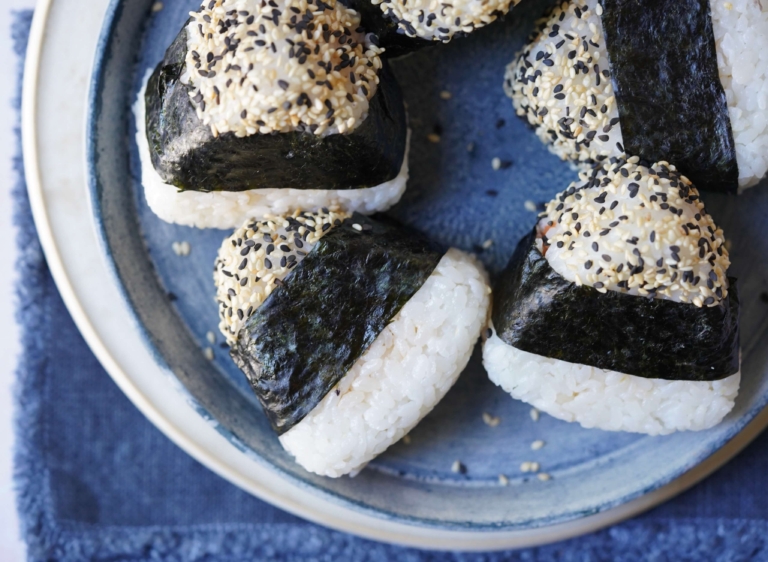
The variety of onigiri flavors and fillings caters to diverse tastes. Here are some of the most common types:
- Salted Salmon: This is one of the most traditional and beloved fillings, featuring salted salmon flakes that provide a savory and satisfying taste.
- Tuna Mayo: A modern favorite, this filling combines canned tuna with mayonnaise, offering a creamy and flavorful option.
- Pickled Plum: Umeboshi is a sour and salty pickled plum, providing a unique and tangy taste that balances well with mild rice.
- Kombu: Simmered kelp, often seasoned with soy sauce and sweet mirin, offers a subtly sweet and umami-rich filling.
- Bonito Flakes: Bonito flakes mixed with soy sauce create a smoky and savory filling, known for its deep umami flavor.
- Spicy Cod Roe: This filling features spicy cod roe, adding a kick of heat and briny flavor to the onigiri.
- Tarako: Similar to mentaiko but without the spiciness, tarako provides a delicate and slightly salty taste.
- Chicken and Teriyaki: Marinated and cooked in teriyaki sauce, this filling offers a sweet and savory flavor that is widely appealing.
- Seaweed and Soy Sauce: Seaweed simmered in soy sauce and mirin, this filling is rich and slightly sweet, complementing the rice well.
- Shrimp Tempura: Featuring a piece of shrimp tempura, this filling adds a crunchy texture and savory flavor.
- Vegetable: For a vegetarian option, a mix of seasoned vegetables such as carrots, bamboo shoots, and mushrooms provides a flavorful and nutritious filling.
By the 1980s, Onigiri had firmly established itself as a staple item in Japanese convenience stores, becoming a beloved and ubiquitous food choice for people across the country. I enjoyed onigiri in several different places while traveling in Japan last summer, some of the the very best were from Seven-Eleven.
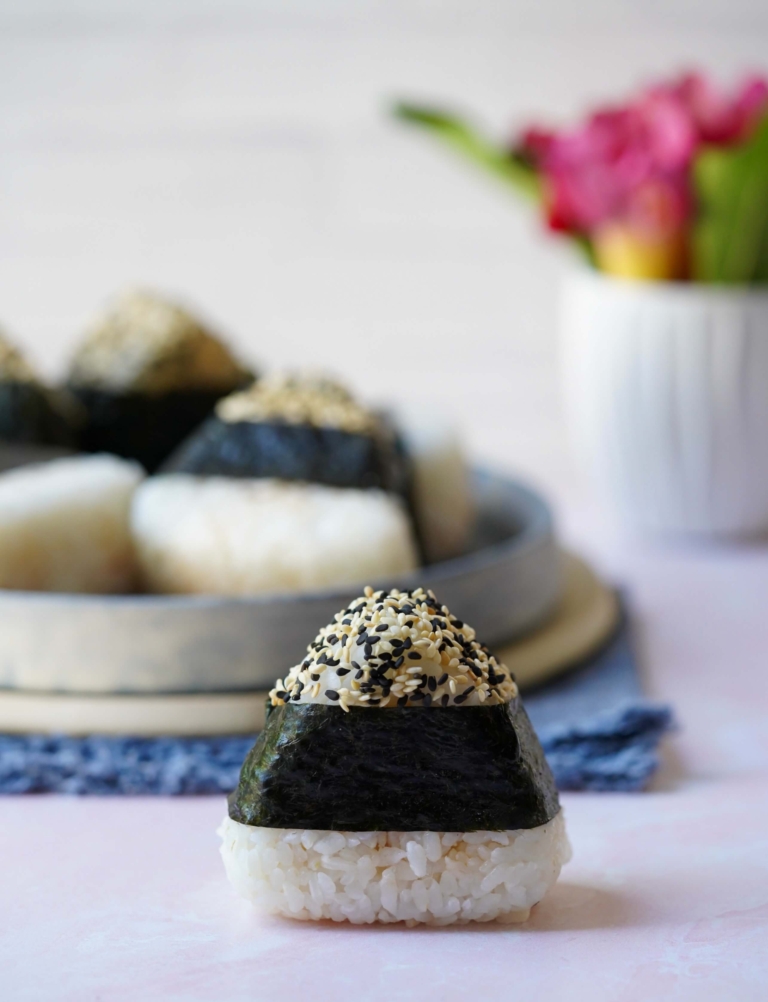
Salmon Onigiri
Ingredients:
- 2 cups uncooked Japanese short-grain rice (sushi rice)
- Kosher salt
- One (8-ounce) king salmon fillet, skin removed and cut into small dice
- 2 tablespoons citrus Ponzu sauce
- 1 1/2 (or more to taste) teaspoons chili garlic sauce
- 2 tablespoons sesame oil
- 3 nori sheets
- Toasted white and black sesame seeds, for garnish
Directions:
- For the Rice: Place the rice in a large bowl, add enough tap water to cover it, and let it soak in the water for about 30 minutes. Transfer the rice to a sieve, rinse, and drain well.
- In a medium-stock pot add the rice and 2 1/2 cups water. Cover the pot with a lid and bring to a boil over medium heat. Once the water is boiling, reduce the heat to low and continue to cook, covered, until the water is completely absorbed, about 10 to 12 minutes. Check the rice after about 10 minutes and if you see any water left, cover and continue cooking as needed until all the water has been absorbed.
- Remove the rice from the heat and let it sit, covered, for another 10 minutes. Uncover and allow the rice to cool until you can hold the rice without burning your hands.
- For the Filling: While the rice is cooling, make the filling. In a small mixing bowl add the diced raw salmon, ponzu, chili garlic sauce, sesame oil, and salt to taste. Mix well and set it near your workstation.
- Cut the nori into 1 1/2-inch-wide strips and set aside.
- To Assemble the Onigiri: Wet your hands to prevent the rice from sticking to them. Scoop a handful (about 1/3 cup) of warm rice into the mold maker or alternatively into one hand if not using a mold. Create a small indentation in the center of the rice. Place 1 to 2 teaspoons of salmon inside. Place a small dollop of rice on top of the salmon. Place the top of the mold over the rice and press tightly to mold it into shape. If using your hands, make sure the filling is covered and gently form the rice into a triangle, using three fingers (thumb, pointer finger, middle finger) to make a triangle corner. Gently squeeze and pat the rice to form the onigiri, but be careful so it doesn’t fall apart.
- Wrap the nori strips around the onigiri and then sprinkle the top point that’s not wrapped in nori with sesame seeds. Repeat the above process until all the filling has been used.
- Serve the onigiri immediately as refrigerating them makes the rice firm up.



These are stunning! Not the usual adjective to describe a snack food, but these are so much more than a snack food. They’re works of art and without tasting one, I know it’s delicious.
I don’t cook much. I love sushi, but never made it. I never heard of onigirl and I never heard of sushi rice (which gives you an indication of what we’re dealing with here).
I do know that I will dream of these and be on the lookout for them and with my first purchase of sushi rice, I will try to make them.
You have a way — and it is amazing.
Thank you for such kind words Roz. Noah is a big fan of these.